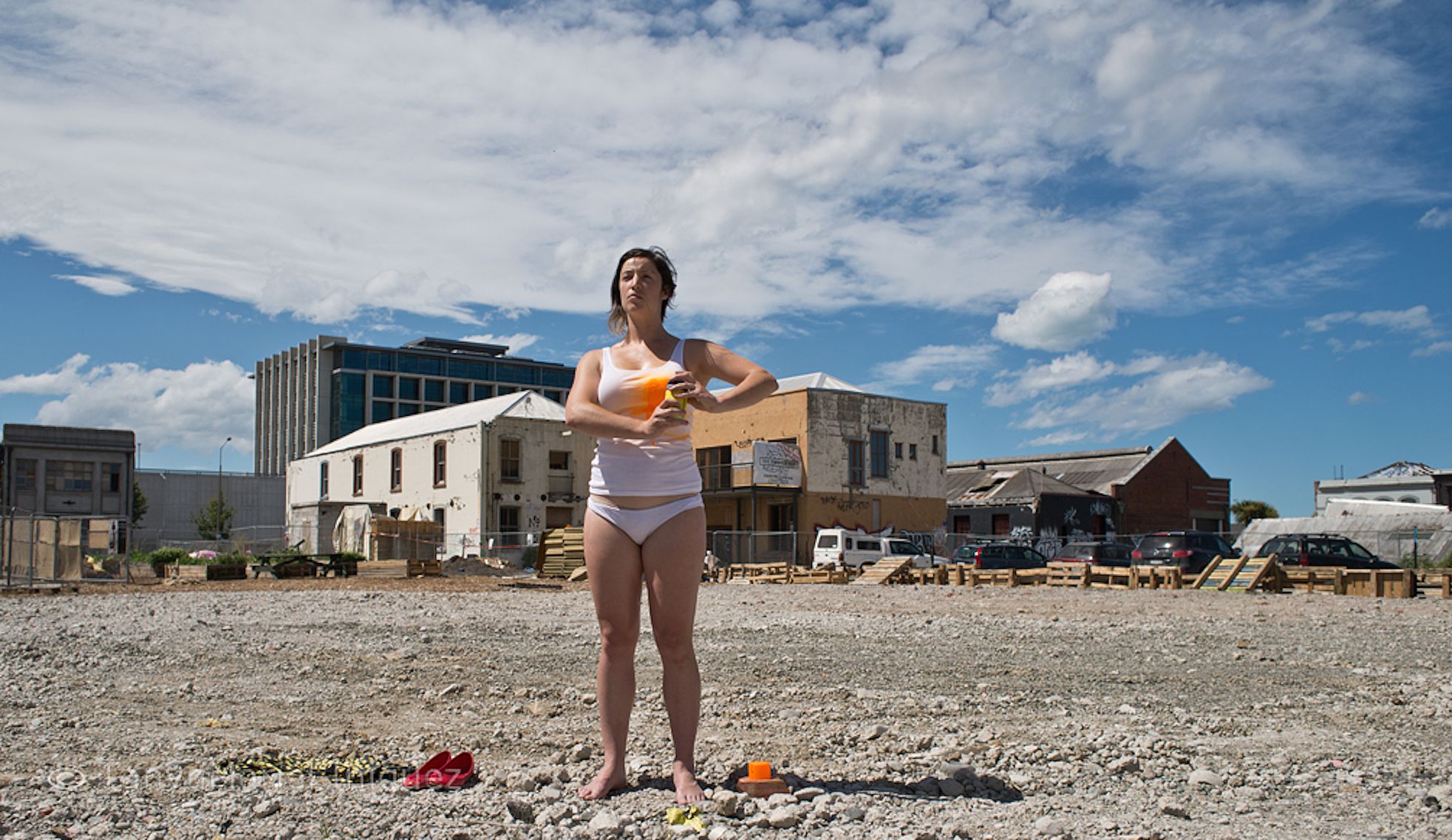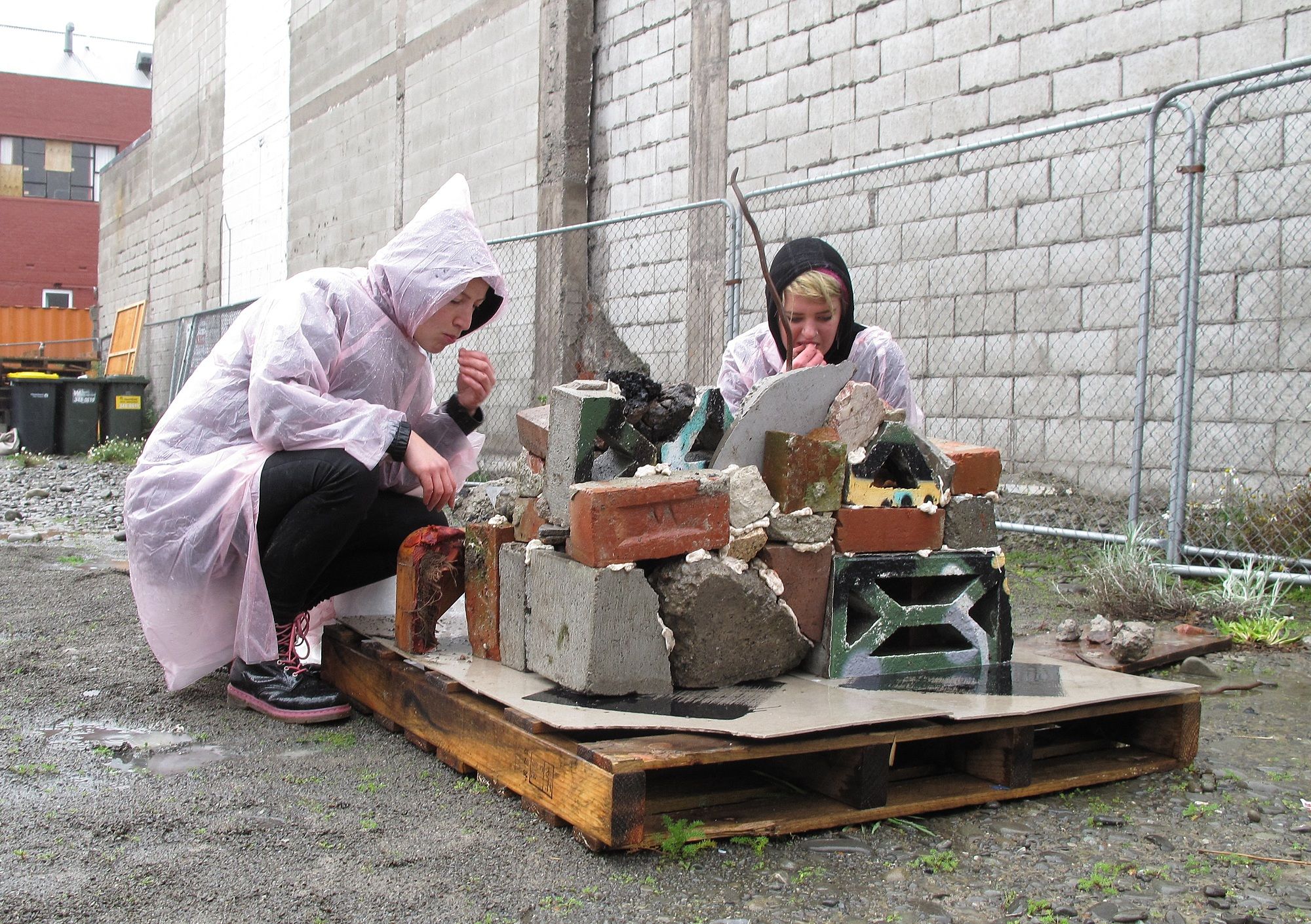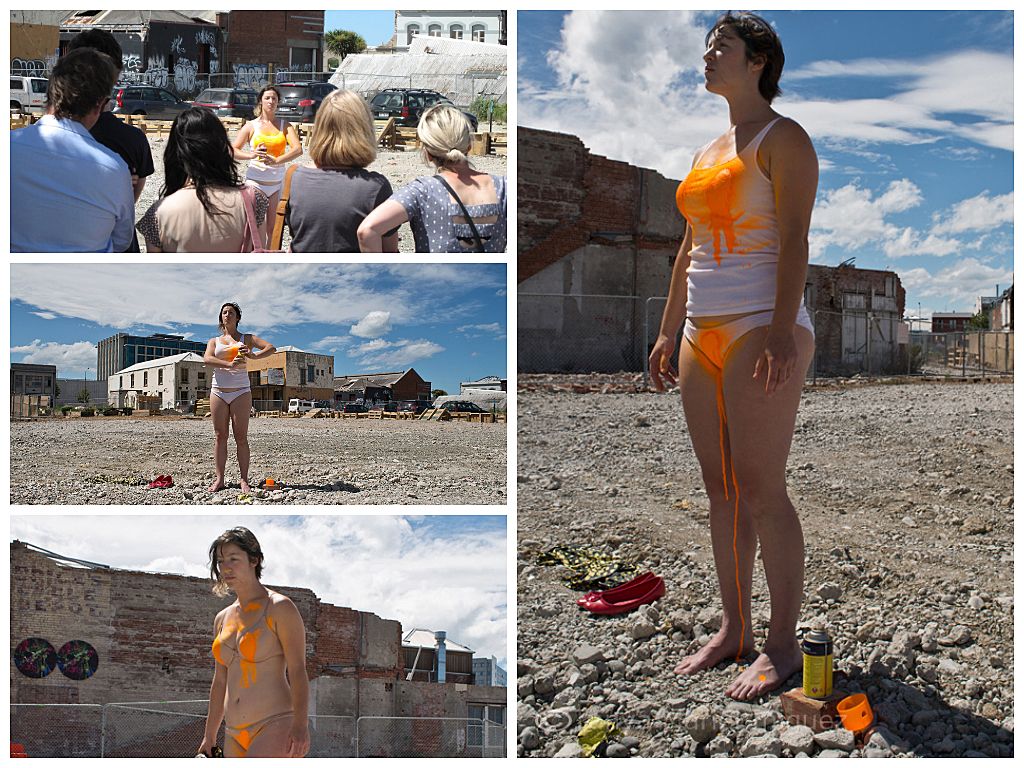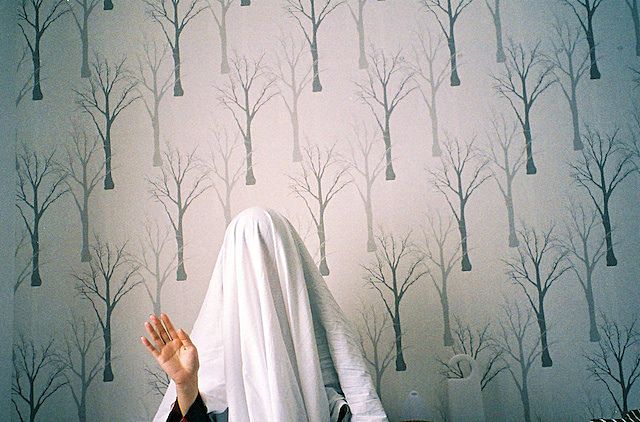Creative Thinkers of Christchurch: Audrey Baldwin
Brie Sherow talks to Audrey Baldwin as part of a series on the creative thinkers of Christchurch.
Performance artist Audrey Baldwin’s work is often flamboyant, but there’s a deeper meaning behind the spectacle. The first time that I experienced her work was on a miserable rainy day in the winter of 2013, when she performed ‘Stuck’ with Julia Croucher on a vacant lot on Gloucester Street, a block north of Christchurch’s Cathedral Square. Unfazed by the weather, they showed up wearing matching pink ponchos and pink-laced work boots. I stood amongst a small crowd in the pouring rain while they chewed through a bulk bag of bubble gum, subsequently using it to piece together painted tiles, chunks of concrete foundation, lengths of rebar, and various other objects found on the demolition site. It was disgusting and impressive. At that time, Gloucester Street comprised vacant lots and ongoing demolitions, and it struck me that Audrey and Julia’s wall was the only new build I’d seen on this block of the central city.
Audrey’s work draws attention to her body as a space in contention, and much of her work is performed on contentious spaces in the CBD. “The personal is political; the body is a good symbol for geography. People are always fighting over the right to spaces.” In ‘Target’, Audrey stood on a vacant section in front of Agropolis Urban Farm and painted her underclothes with orange spray paint, ‘high visibility’ being the prevailing uniform of central Christchurch. It was in part related to her own experiences with objectification but is relevant to every woman in a city now largely populated by male construction workers.
The Agropolis site itself is an interesting reflection of the strange circumstances of present-day Christchurch. LIVS holds an agreement with the landowner but has never been granted official CERA permission for use of the space, and the government authority’s reasoning for evading the application was unspecified. Despite lacking official sanction, Agropolis Urban Farm continues to inhabit the site and LIVS uses the space for performances and events. Much of the city is in similar limbo, hopeful and determined and moving forward despite obstacles and exhaustion.
The collective frustration in Christchurch inspires much of Audrey’s work. In ‘Tether/Reel’ she was naked and attached to a wall crank by six metal hooks inserted into her skin. She kept tension on the line with her body and was at the whim of the audience as they used the crank to reel her from one side of the room to the other. It spoke powerfully to the sense of moving back and forth without ever moving forward, and the idea of the vulnerability that accompanies a lack of control.
Audrey’s pieces are often provocative, but she doesn’t view her work as transgressive. She recalls an impromptu performance staged while still a teenager. It was Valentine’s Day, and she and her friends passed out hundreds of condoms while wearing a postcard promoting safe sex: ‘Sex 60¢’. “We went around at lunch saying ‘Share the love, but not the STDs,’ very tongue and cheek, but also sincere because at the same time I really did believe in it.” Most of the kids laughed it off and the campus was strewn with inflated condoms by the end of the day, but the school staff commended her efforts to promote safe sex.
She gets frustrated when people tell her she’s brave. “It’s not about whether I feel attractive or not; it’s about using my body as a tool to put across a message. I feel like there’s nothing stopping anyone else from doing it, and it kind of implies that I shouldn’t be doing it, and why is that?” It’s the same reaction you get from Cantabrians weary of hearing about bravery in the face of adversity. Living in Christchurch is not about being brave. We are accountable for the future of the city simply by our actions as its residents. When Audrey talks about her art, she could just as easily be talking about moving forward with life in Christchurch. “I don’t really think I could not do these performances. I kind of have to. I’m driven to it.” In the same way that Audrey uses her body to assert control, people in Christchurch are using vacant spaces to re-establish their control of the central city.
Audrey’s involvement with The Social arts collective came at a time when she was considering leaving Christchurch. “I was exhausted, I was depressed as hell, and really cynical because I felt like there was just no space for the arts.” When Gaby Montejo approached her to be a part of his emerging arts collective, she was excited to have a platform for discussion with other artists. It was refreshing to meet people who were motivated to make something happen. “It made me decide to stay. I feel like I’m a lot more invested now. I feel like I’ve got more ownership of Christchurch as my hometown.”
The perceptions of her art change depending on where the work is staged. Her involvement in Christchurch’s burlesque scene allows her to push boundaries within the framework of a more traditional performance. Her own art may be misunderstood sometimes, but “people understand a woman in fishnets.” She describes the gallery as a safer space. “Within those four walls people assume that you’re legitimate and that there is meaning to your work.” People are often reluctant to respond to her work in a gallery, while in public spaces they are more likely to take interest. They may not understand the intricacies of the work, but they’ll engage somehow.
In ‘Nightwatch’ she sat behind glass wearing antlers fashioned from a burning candelabra. Pre-quake she performed the piece in an alleyway leading to Sol Square, a busy nightlife area. Post-quake she staged the same performance in a retail shop at ReStart Mall. In the first iteration she felt as though people took the performance as a challenge and sought to undermine it. She describes being flashed at the Sol Square performance, which she responded to with a smile and a wave of the little finger. “That was really the only movement that I did. I couldn’t help it.” In the second iteration, people were more curious and approached her of their own volition. At ReStart, people still tried to distract her by disco dancing, but she describes their actions as inquisitive rather than aggressive.
Audrey feels that Christchurch’s arts scene has been embraced more post-quake, not only by the public but by local government. “Having the council support public art that is not just metal sculptures and bronzes is what I’ve hoped for all along.” She hopes that it’s not a transient shift, but a permanent investment in contemporary public art that involves the public. She sees a need for more artist studios and cheap apartments in the central city, both for local and international artists and points in the direction of the old council building, saying that it would have been perfect for studios. She describes it in the way that Cantabrians increasingly commonly describe buildings. “It was just over there. Beautiful demolition.” The building had been deconstructed layer by layer, peeled almost, leaving big ribbon windows with a hollow core before it was finally knocked down.
When I spoke to Gaby, he said that Audrey was too good for Christchurch, that her work deserved to be seen in a city with a more international profile. Audrey is inspired by the challenges in this city. Accomplishments here have a relevance and significance often lacking in other places. On a recent trip to Melbourne, she appreciated being in a functioning city but found it artistically uninspiring and full of distractions. “There wasn’t really anything left to do, every niche had been covered, whereas here you’ve almost got a blank canvas.” If you want something to happen in Christchurch then you have to initiate it, but that makes it more authentic. Your contributions are valued; you are not crowded out. She sees potential in future Christchurch and wants to play a part in creating it. There are a growing number of artists from out of town that want to come to Christchurch. “New Zealanders have a habit of thinking that you have to go elsewhere to gain approval before you can come back here and have respect in your own place. We need to be conscious of the fact that what we’re doing and learning in Christchurch is really relevant the world over.”
Also in this series:
Reconstruction and Renaissance
Bridget McKendry of Makercrate




